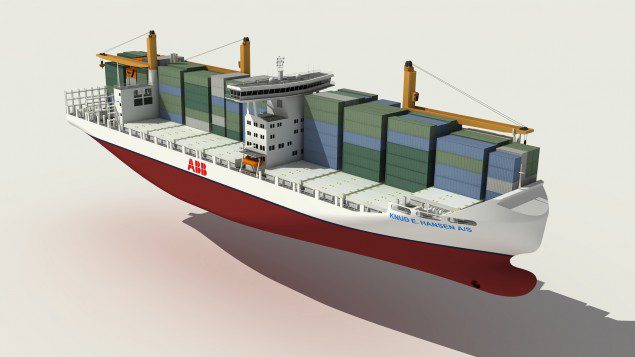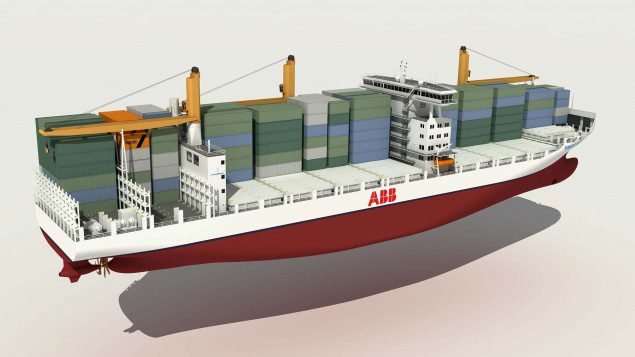
Knud E. Hansen Naval Architects and ABB unveiled a joint project yesterday for a highly efficient 2000 TEU container feeder vessel destined for Thailand. By incorporating the latest in energy-efficient technology such as counter rotating propellers on azipods, an ABB DC power grid system, and a highly optimized hull form and cargo layout, the engineers have come up with a ship that requires 15 to 25% less power per TEU than similar feeder vessels of this size.

I contacted Knud E. Hansen with a few questions about their design,
Jesper Kanstrup, Senior Naval Architect, got back with us this morning:
RA: You mention the ability to conduct a zero-emissions port call in your press release. Why not just plug the ship into the power grid at the port, vice load a battery bank on the deck?
JK: There are two reasons for not plugging the ship into the power grid at port. First of all, it would require a huge power cable and a very high current to charge the necessary number of batteries within the relatively few hours that the vessel will stay in port. Remember that we are talking about battery capacities of several megawatt-hours. And secondly we do not want to carry more weight than necessary. With batteries in containers we can vary the number of batteries that we carry according to the requirements.
RA: Under what conditions would a zero-emissions port call happen? You mention they can happen, but in reality why would they happen – what is the driver for this?
JK: Zero-emission port call is not a requirement in any port today, but if we look 10 to 15 years ahead, many cities in the world will probably have introduced road pricing for all private cars except for zero-emission cars (electrical or hydrogen) in order to reduce the air pollution. And because the air pollution from ship may contribute quite a lot to the total air pollution in a city, ships that can make zero-emission port calls may save on port fees in the future.
RA: Similar container feeder vessels are being designed for use in the Baltic Sea, however they will be incorporating LNG as their primary fuel source. Considering Thailand imports LNG from Qatar, was LNG-power considered for this vessel? Why or why not?
JK: The new vessel is prepared for LNG and dual-fuel. Unlike most other feeder vessels the HFO tanks are arranged in a square block below the accommodation, and some or all of these tanks can be replaced by stacked cylindrical LNG tanks. In feeder ships of a more conventional design, there is simply no place to arrange such tanks. The vessel can be born with HFO tanks, and if LNG becomes relevant it will be quite easy to retrofit LNG tanks in the HFO section. (Of course a dual-fuel main engine would have to be installed in the first place.)

To read up more on this design, check out their press release here.

 Join The Club
Join The Club














